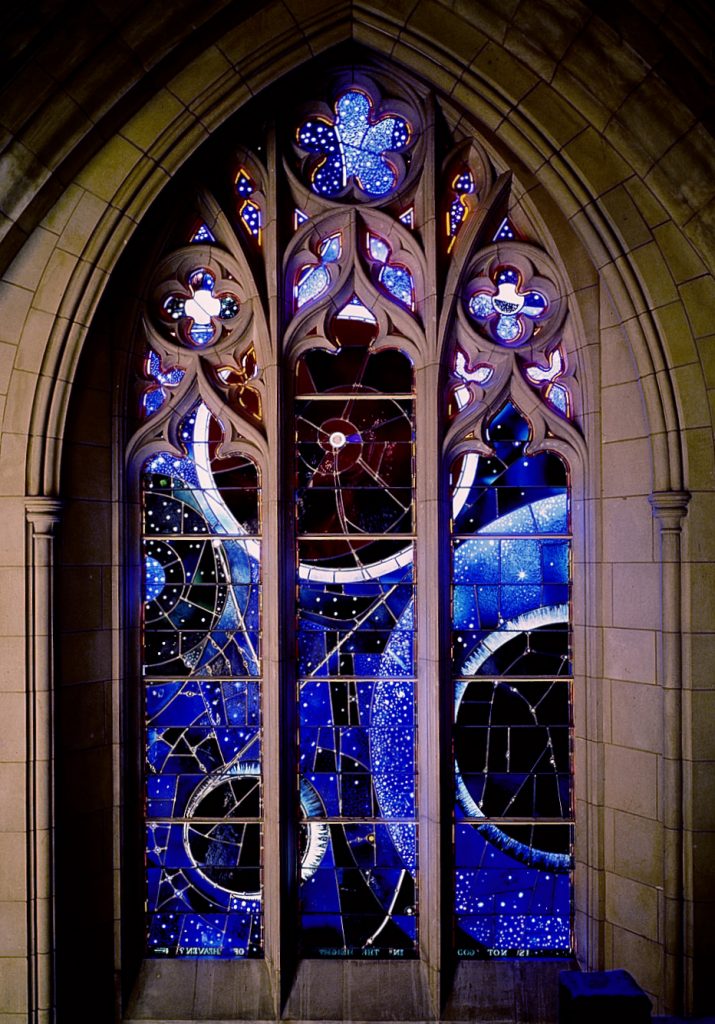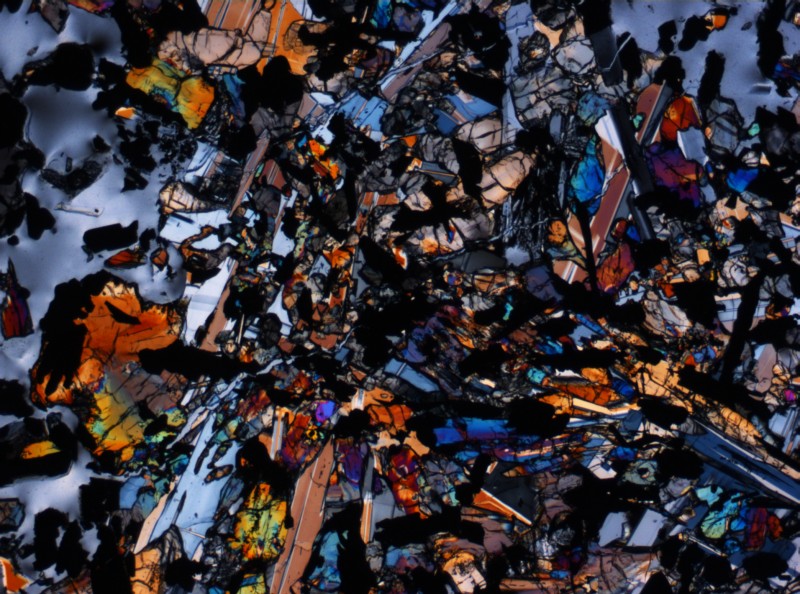by Abbey von Gohren
My first words of my impression of being on the surface of the moon that just came to my mind was ‘magnificent desolation.’ The magnificence of human beings, humanity, planet Earth, maturing the technologies, imagination, and courage to expand our capabilities beyond the next ocean, to dream about being on the moon, and then taking advantage of increases in technology and carrying out that dream.
Buzz Aldrin
Imagine yourself in a darkened planetarium, the faces of your neighbors eerily lit by a cast of blue. The domed screen above is splashed with irregular, crystalline images in indigos, pinks, reds, greens, like a huge abstract stained-glass window in splinters of color and light. You later learn that this is a magnified projection of one of the seven types of rock found on the moon.

There is, in fact, a 3.6 billion-year-old piece of moon basalt embedded in actual stained glass at the National Cathedral in Washington D.C., ensconced in the window which commemorates the extraordinary mission whose 50-year anniversary the entire world is celebrating today: July 20, 2019. Why? Why in a place where we worship God do we honor what appears to be entirely man’s doing? Could this be the ultimate in humanistic hubris, the Tower of Babel all over again? Or somehow oddly appropriate?
The screen above comes alive now. You are at the base of the rocket itself, in a thunderous simulation of the historic launch. Your chest rumbles with the sound of jets, as you hear the countdown, ignition, liftoff! Tears stream suddenly down your cheeks. Why? Is it the thought of all of the people behind this feat (more than 400,000), or all of the world watching it happen together, or the sheer greatness of the endeavor, what man has accomplished together? It is some combination of all of these things when you see a single deed of humankind, suddenly, in its wholeness and magnificence. It is collective, beautiful, enormous, and worthy of praise.
Visiting the local Bell Museum planetarium in St. Paul, Minnesota this past week, I was awed in this way by the enormity of the Apollo projects, particularly the pioneering one in 1969. My three-year-old son sat in his theatre seat with his legs sticking straight out in front of him and his mouth gaping open, half believing (as he did the last time we came) that we were in the spaceship ourselves, taking off into the void. There is no doubt that the idea of catapulting our small selves into the vastness of space is a trembly thing. Perhaps it is something about the precarious nature of the mission that holds undue pride in check. As Neil Armstrong famously said: “It suddenly struck me that that tiny pea, pretty and blue, was the earth. I put up my thumb and shut one eye, and my thumb blotted out the planet Earth. I didn’t feel like a giant. I felt very, very small.”
Paradoxically, then, maybe we are so moved by greatness because it is akin to the Creator stepping back, taking a look at man and woman nobly and specifically placed in creation on the “sixth day,” and calling the entire reality spread before him very good. To gaze upon something well done and speak the truth about it becomes us, since we are ourselves formed in God’s image. As we behold the creations of our own hands and see them as something both separate from us and part of us, this experience moves us, inexorably, since something of the divine image responds and reverberates within.
Much is being made of the accomplishments of humankind in space this year. Certainly, the hype and pomp can begin to ring hollow if it isn’t joined to something greater. The quest for scientific progress can lead easily to self-aggrandizement, political jockeying, and one-upmanship. Alfred North Whitehead’s well-known warning regarding education might very well apply to scientific pursuits as well: “Moral education is impossible apart from the habitual vision of greatness. If we are not great, it does not matter what we do or what is the issue.” Yet running through the complex story of the Apollo 11 space program like a thin sliver of light is the unmistakable beauty of the deed itself. It is simply astonishing, and we do well to be astonished.
It is recorded that about 50 pounds of moon samples were brought back to earth, and every last grain of it went to governmental programs – with the exception of “piece 30 of Apollo 11 rock no. 10057.” This 7-gram bit from the lunar Sea of Tranquility was presented by Buzz Aldrin, Neil Armstrong, and Michael Collins to the cathedral on the mission’s 5-year anniversary. They handed it over with the words: “On behalf of the President and the people of the United States we present unto you this fragment of creation from beyond the earth to be embedded in the fabric of this house of prayer for all people.”
Very good, Apollo 11. Very good.
Interested in exploring further? Follow the links below:
Learn about the history of the National Cathedral’s ‘Space Window’ from Atlas Obscura
Explore close up views of more moon rocks from the Apollo collection at Virtual Microscope.

Abbey von Gohren is from Minneapolis, MN. She teaches French and leads high-school seminars on philosophy, history and literature. Otherwise, she spends her time playing with legos, assembling words into poems, exploring the great wilds of Minnesota, and listening to music made by loved ones.
Header Image: A thin section of Moon Rock 74255 under Cross-Polarized Light at a 2.5x Magnification and 2.85mm Field of View. Credit: NASA





